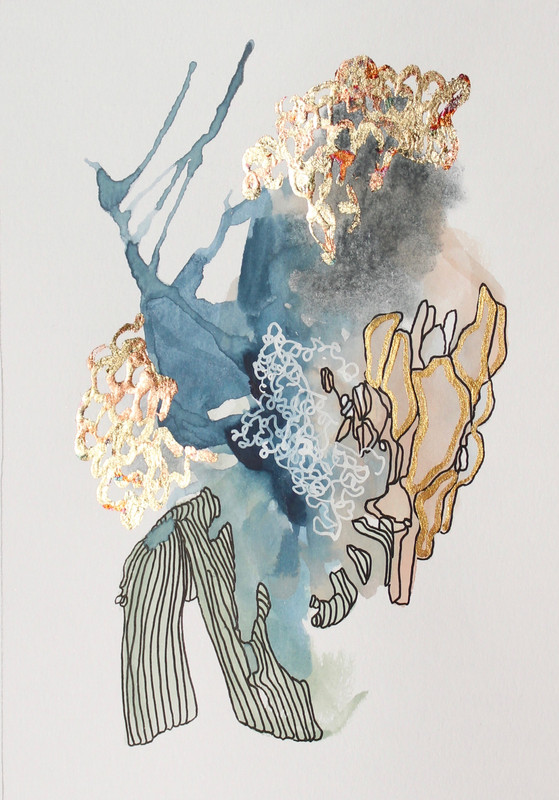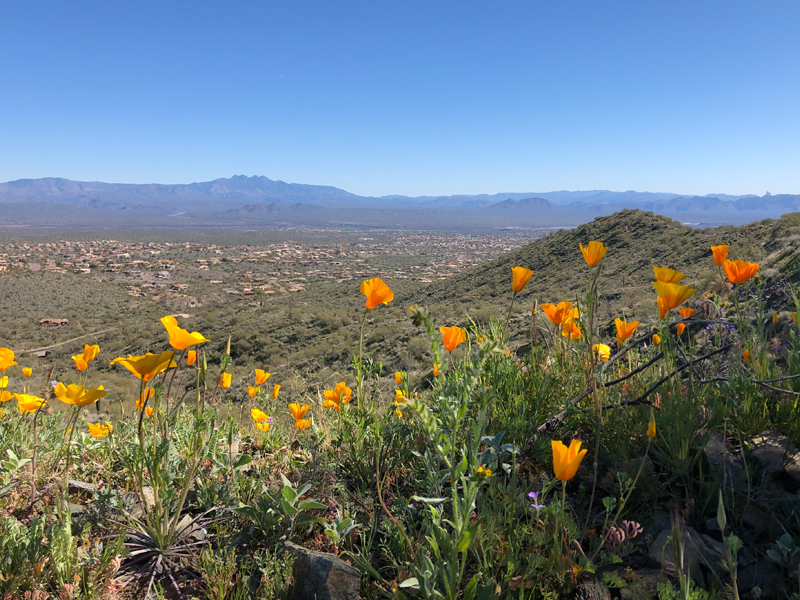
Join the March EcoQuest: Wildflower Wonders.
Find and map as many wildflowers as possible.
Wildflower season is a cherished phenomenon in the Sonoran Desert. Blanketing the desert floor with impressive shapes and colors, these ephemeral wonders have specific requirements that allow them to flourish. Observing wildflowers can provide information on populations and how environmental conditions could be impacting them. These observations can also provide an artistic appreciation of these natural wonders.
Guide to Wildflowers of Metro Phoenix
This month’s EcoQuest is in collaboration with Vision Gallery and Maricopa Native Seed Library.


The Vision Gallery is committed to curating exhibitions that foster community, spark inclusive dialogues, and enrich the livelihood of the Chandler residents. The Gallery at the Chandler Center for the Arts is dedicated to showing artwork from regionally renowned and prolific artists. Both Vision Gallery and The Gallery at CCA are located in the heart of Downtown Chandler and are managed by the Chandler Cultural Foundation. Vision Gallery also hosts free arts classes for youth through its Vision Kids program.
The Maricopa Native Seed Library provides free native seed to the community, as well as free workshops, information and consultations on native plant gardening. Whether you have a lot of space or an apartment patio or balcony, the library makes it easy to grow native plants where you live. You can find seed from the library at various locations throughout the valley.
The spring wildflower displays of the Sonoran Desert are one of the most anticipated natural events of the year. Wildflowers are flowering plants that grow without human intervention and usually only make an appearance for a season. Native shrubs, perennials, annuals and even trees contribute to our wildflower bloom, but we typically think of wildflowers as annual plants, such as poppies and lupines, that appear briefly in the Spring. Annuals complete their life cycle in one season, putting a tremendous amount of energy into quickly completing their life cycle. Many germinate, flower and die in just a few weeks. This strategy allows these plants, also known as ephemerals, to take advantage of short wet periods.
Annual wildflowers usually need a soaking rain of at least one inch in the fall. Earlier and more plentiful rains tend to create super-bloom displays. Temperature also plays a role. The plentiful rain should ideally come after the heat of summer, but before the coldest parts of winter. If these conditions aren’t met, wildflowers will produce fewer flowers and seeds, just enough to support future generations. Seeds can also persist in the soil for up to ten years for some species, providing more insurance for their survival. Because rains are unpredictable, a good wildflower bloom may only occur once in a decade.
For millennia, humans have tried to replicate nature through scientific and artistic means. However, the fallible nature of human hands never allows us to fully capture the intrinsic beauty of nature. When making wildflower observations, take a moment to get closer and inspect their structure. Look at the petal shapes, textures, color combinations and pollen colors. What small details can you see that you may have overlooked before?
Artworks by Mary Meyer and Aimee Ollinger continually approach the natural, with their splendor lying in the artists’ reinterpretation of the organic forms. You can see Mary and Aimee’s work on display in Approaching the Natural at Chandler Center for the Arts from March 6 through April 10. Approaching the Natural quietly expresses the diverse beauty that lies in nature from the hard curved edges in Meyer’s sculptures to the free flowing lines in Ollinger’s work.
 Nature Study 21 by Aimee Ollinger
Nature Study 21 by Aimee Ollinger
See more of Aimee’s work here.
 Luster 26 Detail by Mary Meyer
Luster 26 Detail by Mary Meyer
Observing wildflowers can provide information on populations and how environmental conditions, such as lack of rainfall, extreme temperatures or longer periods of heat, could be impacting them. These observations also give us a chance to slow down and appreciate the artistic characteristics of these short-lived wonders.
WHAT TO OBSERVE:
Any and all wildflowers in metro Phoenix. Wildflowers are flowering plants that grow without human intervention and usually only make an appearance for a season. Be sure to take multiple photos and include as many details as possible for an observation. This can greatly help with identification.
Guide to Wildflowers of Metro Phoenix
PLEASE respect wildflowers.
Picking one wildflower might not cause any harm, but it is important to realize that you may not be the only person picking flowers. The combined impact of 50, 100 or 500 people choosing to pick wildflowers can have a considerable impact on populations. Especially with the recent drought and fires, wildflowers need their seeds to ensure we have wildflower populations in the future. It is also illegal to remove wildflowers from public lands, like state and city parks, without a permit. Private land is also off limits unless you have permission.
Treading, sitting or laying on wildflower habitats is also a problem. By doing this in a wildflower patch, existing plants can be crushed and the soil can become compacted, making it more difficult for wildflowers to get started. This is especially true with repeated use and treading. Stick to the trails and take responsible wildflower selfies.
 Before and after damage to wildflower habitat in just two weeks.
Before and after damage to wildflower habitat in just two weeks.
Sources and more information:
Art, H. 1990. The Wildflower Gardener’s Guide: California, Southwest and Northern Mexico edition. Pownal, VT: Storey Communications, Inc.
Arizona Highways. 1988. Desert Wildflowers. Phoenix, AZ: Arizona Department of Transportation.
Jensen, M.S. 2020. Wildflowers butterflies and more: flora photo ID guide.
Arizona-Sonora Desert Museum: https://www.desertmuseum.org/books/nhsd_plant_ecology.php
EcoQuests are month-long challenges that are part of the larger Metro Phoenix EcoFlora project.
You can learn more and join the Metro Phoenix EcoFlora here.
https://www.inaturalist.org/projects/metro-phoenix-ecoflora
**PLEASE observe COVID-19 guidelines/recommendations.**
This a great opportunity to get outdoors close to home as we all navigate the complications of COVID-19. However, it is imperative that you follow the guidelines/recommendations of your local governments and institutions (wear a mask, practice physical distancing and wash your hands). Do what’s best for you and your community.
Arizona Office of Tourism: Responsible Recreation in AZ
Please do not observe indoor houseplants or pets.
For your own safety and the protection of plants and wildlife, do not trespass when making observations. Please follow all posted rules and guidelines in parks/preserves and do not enter private property.
Do not remove or move natural materials (plants, animals, rocks).
Respect wildlife (do not touch, feed, or disturb animals and keep a safe distance)




